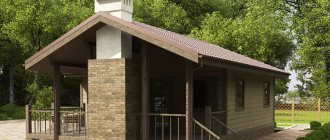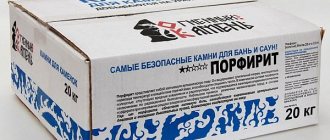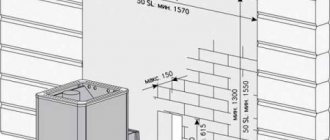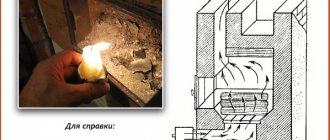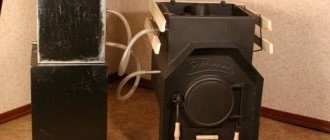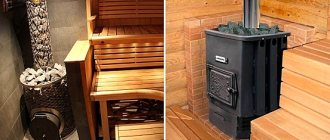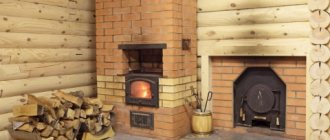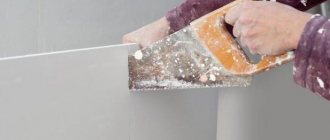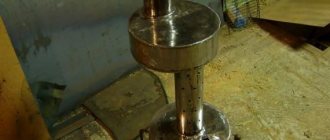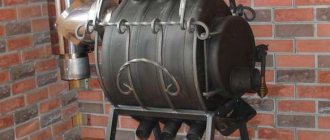Coil
Serpentine (also serpentinite, apothecary stone) is a dark green rock with a characteristic snake pattern.
Most stones of the serpentine varieties range in transparency from completely opaque to completely transparent, are light (specific gravity between 2.2–2.9), soft (hardness 2.5–4), refractory and susceptible to acids. The shine can be glassy, greasy or silky. Colors range from white to grey, yellow to green, and brown to black, and are often streaked. Stones of this group are found all over the world; New Caledonia, Canada (Quebec), USA (northern California), Afghanistan, Cornwall, China, Asia, France, Norway and Italy are famous countries where serpentine is mined, smoothing out emotional outbursts. If we compare, soapstone chlorite and soapstone magnesite certainly hold heat longer - their heat capacity is higher than that of the coil. However, the coil stone is more durable and less susceptible to external mechanical influence. Do not forget that the conditions in which these stones are used (cladding) are not catastrophic, I would even say the stones are absolutely not loaded, compared to those inside the heater :). That is, it is simply pointless to look for mechanical differences under such conditions of use; they are minimal. The chemical composition is another matter. Above, I wrote about what compounds each rock consists of, but it’s difficult to say what they release when heated and how they can affect health. I know one thing for sure, all these breeds have been used in the bathhouse for centuries, many generations have taken steam baths and remained alive and healthy!
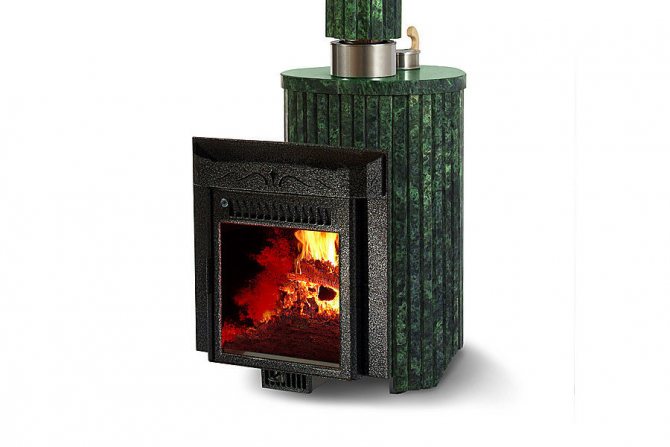
Chemical composition of bath coils
Serpentine is a group of minerals of the same composition, but of different symmetry. Includes several mineral species: antigorite (Mg,Fe2+)3Si2O5 (OH) 4; chrysotile (clinochrysotile, ortho-chrysotile, para-chrysotile) Mg3Si2O5 (OH) 4; lizardite Mg3Si2O5 (OH) 4. Crystals - opaque. The shine is silky, glassy. Hardness on the Mohs scale—2.0-3.0, density—2.6 g/cm3
The coil is a very strong energy source, creating a feeling of protection and peace of mind for the owner. The coil draws out negative formations and emotions from the damaged field, therefore since ancient times it has been used in the treatment of physical and mental illnesses. The mineral helps with headaches, unstable blood pressure, colds, inflammatory processes in the kidneys and digestive system, and relieves increased excitability and nervousness.
Soapstone: features, properties and use
Many of you have probably taken a steam bath at least once in your life. Its beneficial properties have been known since ancient times. Under the influence of high temperature and the generated steam, the entire body warms up. But few people think about what is the secret of such healing properties of the bathhouse. One of the important factors of a good steam room is the right stones to create sufficient heat. One of these representatives is soapstone.
This type of stone has been known since ancient times. It is widely used in construction, being a fairly durable material. There is information about its use for medicinal purposes. Let us consider in more detail the areas of application of this breed, as well as its beneficial properties.
Scope of application of soapstone
The scope of the described stone is wide. In ancient times, several centuries ago, dishes were made from it. It “worked” like a thermos: it kept the hot soup at a high temperature for a long time. The cold was also well preserved. Therefore, in ancient times, soapstone dishes were highly valued. It is still produced today in East Asian countries. And in Finland, the most popular dishes in restaurants are those served in pans made of mineral stone.
Facing tiles (popularly called soapstone) are made from soapstone. It is widely used to decorate the floor of a bath; tiles are often used to construct protective facing screens around a metal stove. If the design of the washing room requires it, it can also be completely decorated using similar material.
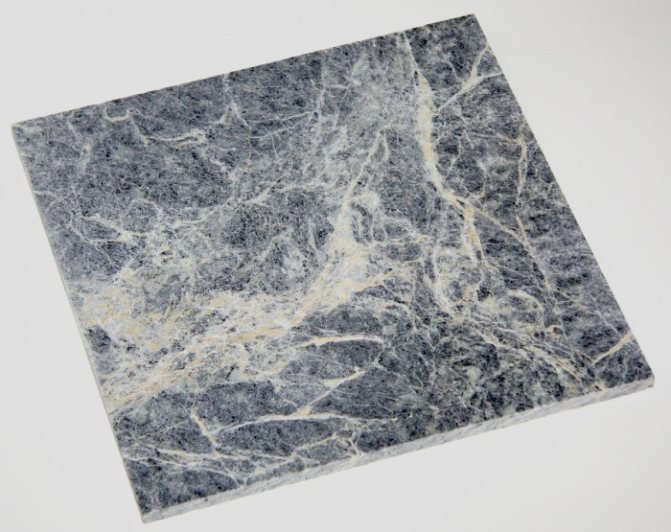
The tile has exceptional properties.
- It is able to evenly accumulate heat and then gradually release it.
- She doesn't mind high temperatures.
- Soapstone tiles have high sound insulation properties.
- It is durable and reliable in use.
- The material does not absorb moisture.
- It doesn't slip.
It has been noted that tiles neutralize electromagnetic radiation well, which is why today many computer rooms in large companies and schools are faced with “soapstone.”
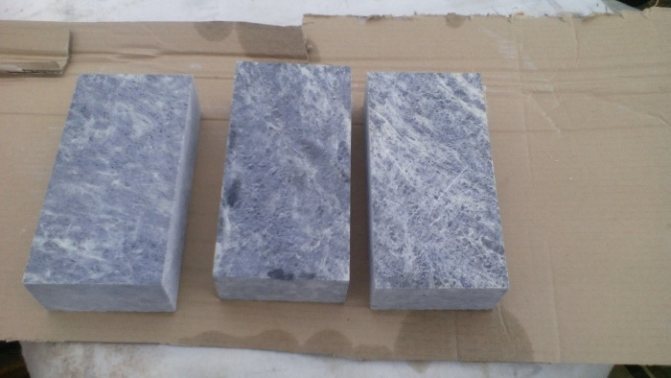
Bricks are also made from soapstone. Its properties are unique. It allows you to align the waves of thermal radiation. Even when exposed to critically high temperatures, soap chloride emits heat, which is very comfortable for the human body. This effect produces a relaxing effect. Brick is used for lining stoves, swimming pools, and walls in steam rooms. Brick has the same properties as tiles. But working with it is much easier than with small modules. While tiles are most often used to create protective screens for stoves, bricks are used to make the stoves themselves. They warm up in about two hours, and then within a day, without additional firewood, they warm up a room of up to 120 sq.m.
Products made from soapstone are also widely used in industry. With the help of mountain material, for example, not only tiles and bricks are produced, but also other soundproofing and fireproof materials. The described stone is also used in the construction of blast furnaces, so its unique properties are a godsend for any bathhouse.
Description
Soapstone is a natural stone of mountain origin. As a rule, it is gray in color, but it can be white or brownish-greenish, depending on the presence of impurities. Sometimes it is called soapstone, soapstone or wen.
It is characterized by high strength and viscosity, and also has a high heat capacity - 0.98 kJ/kg.
It appears to have a smooth structure, but there are also chipped stones with an uneven rough surface. After grinding, they acquire a smooth surface, and then they are called bunded. And when the stone is subjected to more careful processing, special attention is paid to its edges, and then it is called polished.
Characteristics
Soapstone is a natural building and decorative material, a rock of metamorphic origin, consisting of talc (40-50%), magnesite (40-50%) and chlorite (5-8%). mineral and chemical composition are variable.
It has high strength and toughness. Can be sawed without crumbling. This stone is resistant to temperature changes. Due to the magnesite content it has increased strength. It has a high heat capacity (higher than jadeite), so it is often used for interior decoration of baths. Soapstone can heat up in 5 minutes in ordinary boiling water, while cooling down for about an hour. Soapstone does not absorb water and is very varied in texture.
The main indicators that are important for the use of stone are their density and heat capacity. For convenience, see these characteristics of jade in the table.
| Table. Physico-chemical characteristics of soapstone | |||
| Name of the stone | Density (kg/m³) | Heat capacity, kJ/(kg K) | Average price for 10 kg (rubles) |
| Soapstone chlorite | 2700-3200 | 0,98 | 200 |
Application
It looks like marble. They have long been used to cover the facades of buildings. It is considered one of the best bath stones due to its beneficial properties. It retains heat perfectly. Withstands temperatures up to 1600 degrees for a long time. It gives off heat for a long time, allowing you to save on electricity or firewood. Soapstone is used in the form of crushed stone, powder and slabs. Soapstone is used to produce tiles, modules for lining stoves, souvenirs, and aromatic bowls.
Soapstone is not for nothing called potting stone; it is used to produce vessels in which drinks are kept both warm and cold, depending on their initial temperature, becoming a kind of thermos.
The stone’s ability to retain stored heat or cold longer than others has not gone unnoticed. Since ancient times, people have made dishes from it, which, after heating, retain the heat of the dish filling it, as well as stoves and fireplaces, which give off heat from burnt logs for many hours. Environmentally friendly soapstone does not absorb any tastes or odors, and also does not enter into chemical reactions with drinks, food and detergents. Due to the presence of such properties, it is used as whiskey stones.
Due to the fact that it is environmentally friendly, it can be used as soil for an aquarium. It is especially suitable for keeping cichlids in an aquarium, which like to hide in large stones.
There are several types of this stone for processing:
- crushed stone, the most inexpensive
- bunded, its surface is lightly sanded, the edges are to be leveled, sharp corners are removed
- polished, the edges are already subject to deep processing, the shape is leveled and the surface is polished. Such a stone is already more expensive, it is suitable for cladding walls and laying on the very top of the heater as it has an attractive appearance.
There are 2 types of stoves made from this stone:
- stoves, which consist of a cast iron firebox and a body made entirely of this stone;
- fireplace stoves that are not completely lined with soapstone.
Composition and properties
The question may arise: how soapstone differs from soapstone magnesite. Based on the name, it is not difficult to guess what it consists of: talc (40-50%) and chlorite (5-8%), in the second case the composition includes magnesite (40 to 50%).
The fact is that both types contain talc, but in the case of a predominance of chlorite content - 30-35%, and magnesite only 5-10%, it will be called soap chlorite.
There are many different opinions on this matter: some say that these are completely different stones, while others say that they are basically the same thing. But, of course, depending on the predominance of one or another element, their properties and areas of application will differ.
Let's consider their components separately.
Talc is a mineral that looks like a white crumbly powder that feels greasy to the touch. Surely many have encountered it when using baby powder or putting on latex gloves. However, under natural conditions it is a soft stone.
Chlorite is a mineral belonging to the silicate group. It got its name not at all because of the chlorine content, as it might seem at first glance. The whole point is in the literal translation, from the ancient Greek “chloros” means “green”. Therefore, it is also called green stone, although it can have other shades.
The stone is also particularly soft and flexible, due to which it can easily be separated under various mechanical influences.
Depending on the predominance of one or another element, soapstone can be green, cherry, or blue. It is characterized by high strength, its density is 2700-3200 kg/m3. It is easy to process and almost does not crumble. Another feature is that it practically does not absorb water.
One of the most important aspects of its application is also the ability to release heat slowly, since talc is a poor heat conductor.
This undoubtedly makes it one of the worthy representatives that are suitable for use in a bathhouse.
There are several other amazing properties this natural mineral has. It is believed that when heated, this stone is capable of releasing vitamin D, which has a beneficial effect on the development and strengthening of the human skeletal system. However, this issue is still controversial.
There is also evidence that when using this stone in a bath, it improves the general condition of the body, lowers blood pressure, and helps in the treatment of osteochondrosis and radiculitis. You can verify the veracity of these properties only by trying it yourself.
Let's start with the fact that this is a natural material from the category of metamorphic rocks. Soapstone consists of:
40-50% - talc.
40-50% - magnesite.
5-8% - chlorite.
In different regions there is a composition that differs in its content. Somewhere there is more talc, somewhere magnesite, and so on. It should be noted that soapstone, which is greenish or bluish in color, is most often mined in Karelia.
Other characteristics:
High strength due to magnesite content.
Good viscosity.
Easy to process without crumbling.
Material density 2700-3200 kg/m³. Quite a heavy stone.
High heat capacity (0.98 kJ/kg K). If we compare this figure with materials such as fireclay bricks and jadeite, then it is almost twice as high. For example, if you place a telcochlorite tile in boiling water, it will heat up within five minutes, but it will take an hour to cool down.
Almost zero water absorption.
Quite a wide range of color shades.
PROPERTIES OF SOAP CHLORITE
As mentioned above, soapstone was used in the treatment of sick people.
The thing is that when heated, the stone releases vitamin D. It is this vitamin that is used to strengthen bones in adults, and is also a prophylactic agent in the treatment of rickets in children.
Soapstone helps lower blood pressure, plus strengthens the body's immunity.
With its help, brain activity increases, perseverance becomes high, and the same goes for attentiveness.
Copes well with acute respiratory viral infections and acute respiratory infections.
The soft warmth emitted by soapstone allows you to cope with diseases such as radiculitis and osteochondrosis.
Many people believe that soapstone is a masculine stone. That is why it is recommended to be used in baths where men take steam baths. He fills them with masculine Yang energy.
Scientists have proven that by installing soapstone tiles in a bathhouse or sauna, you get a radiated background of soft origin. It's relaxing.
Let us add that finishing a bathhouse or sauna with soapstone tiles is not only a health benefit, but also a very noble design of the interior and facades.
Chemical composition:
SiO2 – 30-33% MgO – 27-32% CO2 – 20-21% H2O (water of crystallization) 2-3% Fe, Fe2 – 8-10% CaO – 1-2% Al2O2 – 1-2%
It is thanks to the talc content (SiO2) that soapstone is easy to process, and the magnesite content gives it excellent strength properties. Talkomagnesite is characterized by high performance indicators. It has high strength and density, high thermomechanical properties, and is resistant to aggressive environments; At the same time, soapstone is an environmentally friendly stone and has aesthetic beauty.
Thermal conductivity
The thermal conductivity of soapstone, compared to other materials, is quite high due to its high density and mineral composition. It is thanks to this characteristic that the stone heats up quickly and evenly, from all sides.
Heat accumulation
Due to its high density, soapstone has a unique property - it quickly heats up from fire, accumulating heat, and cools very slowly, releasing it evenly. The heat capacity of soapstone is 2.5 times higher than that of oven bricks. The ability of soap-magnesite fireplaces and stoves to heat fairly large rooms and release the accumulated heat evenly over 20-30 hours is explained precisely by the large heat capacity of soap-magnesite.
Density
Talkomagnesite is a soft stone, and one of its features is porosity. Therefore, it contains tiny particles of water and air, and the presence of water (or water getting on the stone) will further enhance the heat capacity and thermal conductivity of the stone (the thermal conductivity of water is 20 times greater than the thermal conductivity of air, and the heat capacity is, accordingly, 4 times). On the other hand, the presence of pores in the stone is so small, and the density is so high, that even under high pressure, exposure to moisture, or heating, soapstone will not deform. High density provides soapstone with exceptional strength.
Impact of temperature
It has been established experimentally that soapstone does not react to high temperatures and is able to withstand heating from 1200°C to 1600°C for a considerable time (depending on the type of stone). Under the influence of temperature, the stone does not crack, does not change its shape or color.
Corrosion resistance
The corrosion resistance of soapstone is usually determined in a cryolite-alumina melt, as well as in a 30% sulfuric acid solution. Studies have shown that the resistance to oxidative processes of stone increases with increasing temperature. Accordingly, the use of stone as a material for fireplaces and stoves is already a guarantee of their “protection” from corrosion. Thus, strong chemicals and acids are not capable of harming soapstone. It is this property that can explain the manufacture of dishes in the recent past in areas where there are deposits of soapstone.
Environmental indicators
The most important environmental indicators of soapstone are the absence of radioactivity and substances harmful to the human body (for example, asbestos). Talkomagnesite is an environmentally friendly stone, its characteristics comply with the legislation of the Russian Federation in the field of sanitary, hygienic and radioactive safety.
Beneficial features
Due to its exceptional heat capacity (namely, the ability to release heat for a long time and evenly), in the medical environment the stone was often called a “natural heating pad” and was used in the treatment of radiculitis, osteochondrosis and other diseases in which pain subsides with prolonged heating of the sore spot. Thermal radiation has a beneficial effect on health because the frequency of thermal radiation between humans and soapstone coincides and is 8-9 microns, which is why this heat seems so soft and relaxing. People who use soapstone stoves in their homes note that their use has a positive effect on their health - they suffer from fewer colds and flu, their blood pressure improves, their metabolism is normalized, etc. The thing is that a heated stone is capable of releasing soft, oxygen-rich steam - which has a healing effect on the human body. Now it seems no coincidence that in ancient times even magical amulets were made from soapstone, and even now therapists talk about its healing properties.
Aesthetic properties
In addition to all the above qualities, soapstone has one more thing - beauty. The palette of its shades - from simple rough light gray, or aristocratic pearlescent, silver to deep and soft blue, life-giving green - can satisfy every taste and look flawless in any interior. In its external structure, processed soapstone resembles marble. In general, soapstone gives the impression of a noble material - a material with a long history, products from which are worthy of being passed on from generation to generation. Moreover, thanks to the totality of its properties, soapstone magnesite has become widespread in the architecture of stone buildings - the famous Drentheim Cathedral in Helsinki, St. Michael's Cathedral in Turku, a large number of buildings in St. Petersburg are framed and some parts are made in soapstone magnesite.
Physico-chemical properties of soapstone
Specific gravity (density) – 2.8-3.0 g/cm3 Compressive strength – 25.0-100.0 MPa Cohesion – 7.0 MPa Thermal conductivity – 3.5-4.7 W/(m °° C) Heat capacity – 800-900 J/(kg °C) Fire resistance – 1230-1360°C Water absorption – 0.3% Acid resistance – 39.0-41.0% Abrasion – 1.43 g/cm3 Electrical conductivity – 0. 44·10-7 Breakdown voltage – 20.0 kV/s
Field and production
One of the main locations of soapstone is Nunnalahti, which is located in Finland. It is here that most of the reserves of this natural treasure are concentrated. Intensive stone mining has been going on in this area for many years. That is why Finland is one of the main countries with huge reserves of this natural wealth.
There is also information that natural reserves of this mineral are located in countries such as America, India and Brazil.
In Russia, work is also underway to extract soapstone magnesite. In Karelia, this material began to be mined and actively used back in the 18th century, which was due to its demand as a building material. Currently, products from this stone are produced industrially.
Advantages and disadvantages
It is very important to choose the right stones used in the sauna heater. To do this, it is important to take into account both the beneficial and harmful properties of each type of stone. Soapstone chlorite is a worthy candidate in this regard, as it has a number of positive properties:
- due to its porous structure it is easy to process;
- is a good insulator;
- reaches heat quickly and cools down slowly, which is a particularly important indicator for baths and saunas;
- the steam emanating from it is enriched with oxygen;
- is considered an environmentally friendly substance, without harmful impurities;
- does not crack or break when exposed to high temperatures;
- is a good material for lining sauna stoves, preventing the rapid occurrence of corrosion;
- resistant to environmental influences;
- reusable;
- has high thermal conductivity.
In addition to the advantages, there are also some disadvantages to this material.
One of the main disadvantages of using it in a bathhouse is that this stone is dusty. This is due to the large amount of talc contained in this stone.
In principle, soapstone is an environmentally friendly stone, and the dust released will not cause harm to health. But at the same time, if you treat it correctly and carry out all the necessary procedures (rinse thoroughly with water and burn it over a fire), then such consequences can be avoided.
I choose:: stone for cladding the stove
Finishing a sauna stove is one of the most important stages in the process of building a sauna. As a rule, finishing is done with materials that have good heat transfer, a high degree of fire resistance and water-repellent properties. The most common natural stones that are used for cladding sauna stoves are: soapstone, jadeite, magnesite. We will talk about them further.
Furnace finishing with soapstone
Soapstone is a rock that was formed from soft minerals, where talc and magnesite are combined so that talc plates grow into the magnesite. As a result, all this is a stone of a noble gray-green color. The stove, which is lined with soapstone, after accumulating heat, releases it for a long time, evenly distributing it throughout the room. Of course, soapstone is much more effective than brick. The heat generated by soapstone is not aggressive and harsh, but, on the contrary, increases people's immunity to various diseases, lowers blood pressure, and improves metabolism. Stoves lined with soapstone have a fairly attractive appearance and are suitable for any bathhouse interior. The steam from such a stone is very soft and does not burn the skin. The facing work has a “dry” appearance, that is, without the use of cement mortar, which gives reason to talk about the long service life of such finishing.
Soapstone is used not only for finishing sauna stoves, but also for lining fireplaces and steam room surfaces. The stone can be of various color shades: from gray-blue to light green.
Coil stone
Another name for this stone is serpentinite (from the Latin “serpens”, meaning “snake”). Indeed, in appearance, the surface of the stone is very similar to the texture of snake skin. Previously, the serpentine was called the “apothecary stone”, and for good reason, because it was believed that thanks to it the effects of many medicines were enhanced. The serpentine stone is a very strong energy stimulant that protects its owner, and at the same time gives him a sense of peace and mental balance. Much is said about the incredible healing properties of serpentinite. Therefore, when a sauna stove is lined with a coil, the steam emanating from it automatically becomes healing.
Jadeite stoves
Jadeite is a rather rare mineral, very similar in appearance to jade stone. Jadeite can be either transparent or opaque, but its obligatory difference is the color scheme - emerald green. The color intensity of the stone may vary. The main advantage of this mineral is its high degree of strength and at the same time low degree of moisture absorption. The stone is supplied crushed in blocks or already polished slabs.
By the way
Massage using stones (stone therapy) is carried out using jadeite: massage tables and stone therapy sets are made from it.
Magnesite furnaces
Magnesite is a natural stone that consists of talc and magnesite. If your stove is lined with this mineral, then rest assured about your health: immunity increases, metabolism improves. When water hits hot magnesite, the air in the room is ionized, which has a very good effect on the respiratory system.
Of course, there are many ways to decorate sauna stoves, including not only natural stones, but also ceramic tiles. Since the 15th century in Rus', stoves have been lined with tiles (the front side of ceramic tiles has a special relief, texture, and decor). A stove lined in this way will become a real decoration of your bathhouse and will delight the eye for a long time, creating comfort and coziness.
How to choose a stone for a bath
When building a bathhouse, most people pay great attention to the decoration of the steam room, carefully selecting wood for the walls and benches. At the same time, the question is: “Which stone to choose for a bath?” usually not worth it. And it’s completely in vain, because the atmosphere in the steam room and its healing properties depend on the choice of the type of stones.
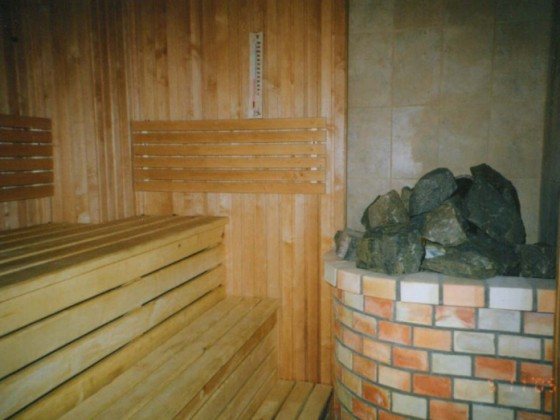
Classic Russian steam room
However, any bathhouse owner sooner or later comes to the question of choosing stones. The stones, chosen at random, begin to crumble and crack, the atmosphere in the steam room leaves much to be desired, and you can feel the difference between visiting your own bathhouse and a sauna with friends. Of course, a thrifty owner asks this question even when building a bathhouse, but better late than never.
Other stones for finishing baths and saunas
There are two more stones that are used today in finishing processes in baths and saunas. These are jadeite and quartzite.
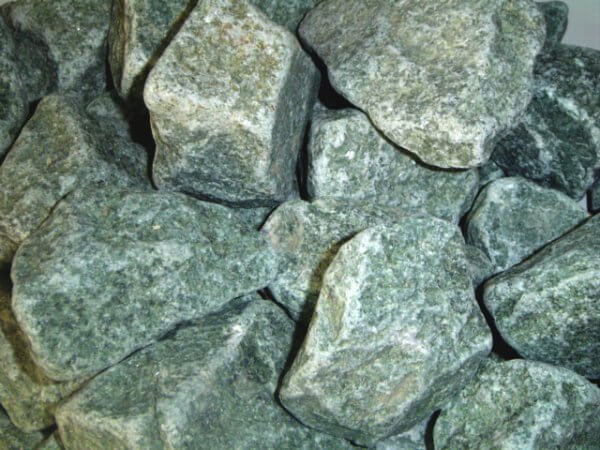
Jadeite is a semi-precious stone with a pleasant greenish color that is somewhat reminiscent of malachite. But it is several times stronger than the second one, so it is valued higher. Jadeite is mainly mined in China and Kazakhstan. In Russia, it is found in small quantities in the Urals.
Its durability and noble color became the reason for lining stoves in baths and saunas. The most important thing is that cladding with jadeite ensures long-term operation of the stoves. There are several classes of this stone, depending on the color green shades. Saunas and baths are usually finished with a class - Utility.
In order not to compare jadeite with other stones for finishing baths and saunas, we will immediately make a reservation that this is the best option that can be recommended to those who are deciding which stone to choose for finishing a bath or sauna. Although it is the most expensive.
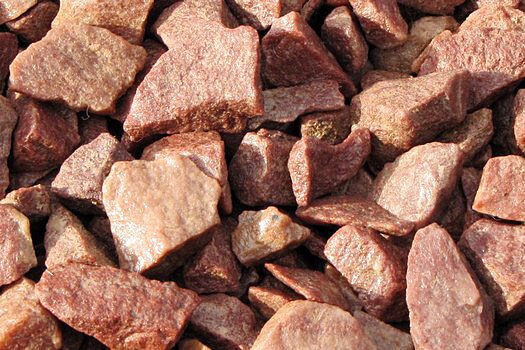
Quartzite has the same origin as jadeite and soapstone. It has one feature that sets the stone apart from other types of cladding. If you splash cold water on heated quartzite, so-called atomic oxygen, that is, ozone, will be released from it along with steam. Remember how it smells after rain. You will smell the same smell in the bathhouse.
This gas saturates the blood with oxygen, your health immediately improves, and brain activity is activated. At the same time, the quartzite begins to emit electromagnetic vibrations. By the way, this physical effect is called the piezoelectric effect.
The most popular quartzites are white (often called “hot ice”) and crimson. By the way, white quartzite quickly fails. Temperature changes negatively affect its structure. Raspberry quartzite is more stable in this regard. By the way, both options are often used not for finishing, but as rolled stone to fill the heater.
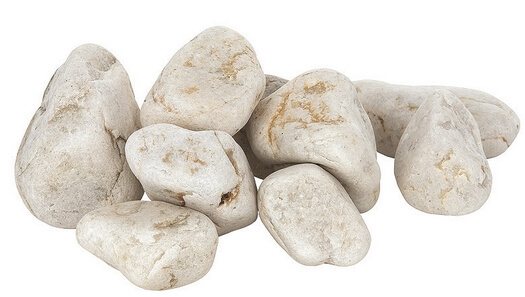
Types of stones for baths
When choosing stones for a bath, a systematic approach is needed. You should carefully study all possible types of bath stones. Let's first consider the requirements that apply to them.
- Density The bath stone should be smooth, dense and uniform in structure. Foreign inclusions, such as mica, are categorically unacceptable. Such materials are beautiful, but short-lived and quickly crack when doused with water. Small fragments can fly in different directions and pose a danger to people.
- Ability to accumulate heat. Not every material accumulates heat well. It is better to give preference to material of volcanic origin.
- Form . Round or oval shaped stones are best. The absence of sharp corners promotes better air circulation due to more uniform heating.
- Dimensions. The diameter of the samples depends on the size of the furnace. Usually it ranges from 7-14 cm. Large stones are poured on top of smaller stones to ensure uniform heating of the entire heater. Their diameter is chosen within 3-5 cm.
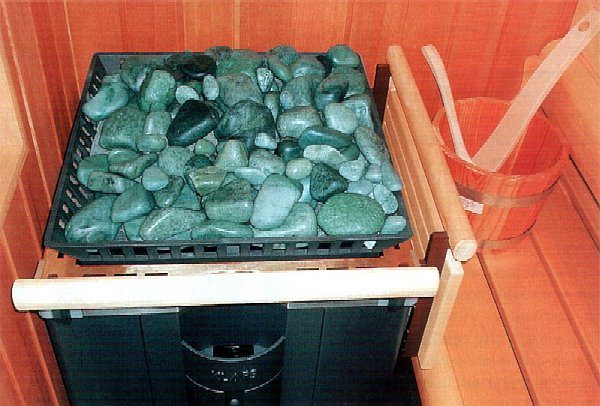
The photo shows an example of correctly filling a heater with samples of different sizes.
In order to understand which stone is best for your bath, let’s take a closer look at its most common types.
Jade
A greenish semi-precious stone, known since ancient times. Even the Mayan Indians made their amulets from it. In China, jadeite was used not only to create steam, it was used to line walls and make furniture in the imperial baths.
Jadeite is rightly considered one of the best options due to its beauty and durability.
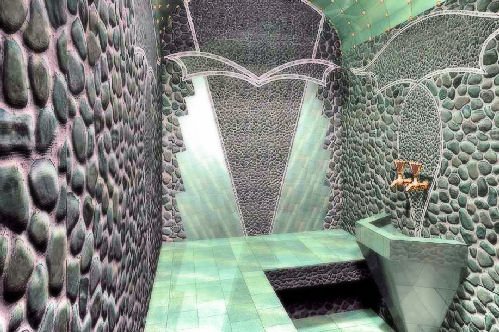
In the photo - jadeite finishing
Chip and polished jadeite is available for sale. In the east, they prefer crushed jadeite for decoration, believing that it absorbs “bad energy.”
In addition, it is generally accepted that jadeite helps with problems of the gastrointestinal tract, diseases of the joints, genitourinary system, normalizes blood pressure and heart function, and helps strengthen the nervous system.
Note! The main condition for the manifestation of the healing properties of jadeite is its placement on top.
It is not known whether this is actually true, but jadeite reliably has the following advantages:
- Retains accumulated heat for a long time;
- Ionizes the air;
- Is a source of IR radiation;
- Does not split;
- Has the property of enriching water with metasilicic acid;
- Retains medicinal properties for at least 5 years.
According to all reviews, both from specialists and ordinary sauna lovers, it is believed that jadeite is the best stone for a sauna stove. If you use it to decorate a steam room, then the price may be quite high, but what can stop a true connoisseur?
Soapstone chlorite
Soapstone or soapstone is an excellent candidate for use in your bathhouse and sauna. Compared to brick, its heat capacity is 2.5 times higher, while it heats up 10 times faster.
Recently it has become fashionable to build stoves from soapstone. Such stoves combine all the advantages of stoves with open and closed heaters, namely: with relatively small sizes they have high heat capacity.
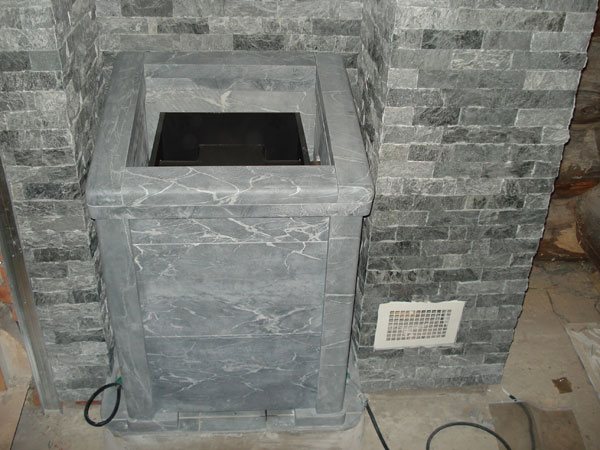
The photo shows a “Castor” stove lined with soapstone.
The medicinal properties of soapstone include increased immunity and normalization of blood circulation, as well as accelerated removal of phlegm from the lungs and acceleration of metabolic processes.
The latter means that soapstone for bathing promotes rapid weight loss. Scientists claim that one such visit allows you to lose up to one and a half kilograms of excess weight.
Coil
Serpentine or serpentinite is a greenish stone that gets its name because of its characteristic “snake” pattern. Coil stone for baths is used mainly in the form of facing tiles for walls and stoves.
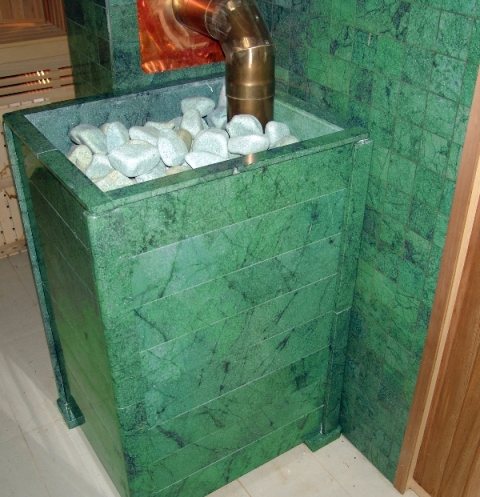
In the photo - finishing of an open heater and a wall with serpentinite tiles
The healing properties of a coil in a bath include improving the general condition of the body. It calms the nervous system, helps with colds, diseases, kidney inflammation, and stabilizes blood pressure.
Crimson quartzite or royal stone
A completely unique stone, capable of withstanding temperatures up to 2700 0 C. It received its second name “royal stone” for good reason.
This gift from Karelia was revered not only by Russian autocrats for its remarkable decorative properties. For example, the sarcophagus of Napoleon Bonaparte was built from it.
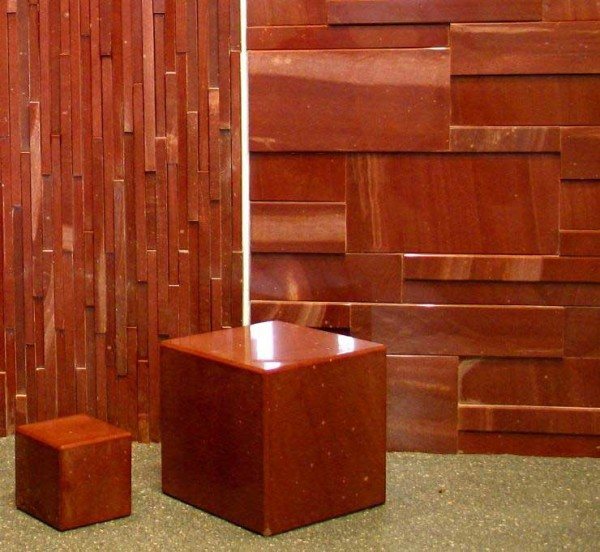
In the photo - cladding made of crimson quartzite.
Crimson quartzite is especially appreciated by fans of “light steam”. This bath stone warms the body well and treats rheumatism, hypertension, muscle pain and salt deposits.
Salt rocks
Salt stones for baths stand apart from traditional materials. The Himalayan salt from which this material is composed has a healing effect on the entire body.
Useful properties of the mineral
Ice, soap, pot and stove - all these names are definitions about the stone, which in geology is called soapstone.
And each of these names is conditioned by something. For example, it is called pottery due to the fact that it has been a raw material for the production of dishes since ancient times. The mineral acquired the indicative name “thermos stone” because containers made from it retain not only heat, but also cold for a long time. Champagne or beer in such a vessel will remain ice-cold for several hours.
There are many areas of use of soapstone. It perfectly shields electromagnetic radiation, so it is widely used for decorating the walls of laboratories, computer rooms, etc. Floors made of this stone have good sound insulation and muffle unwanted extraneous noise. Some companies use it in the production of acoustic speakers.
Soapstone is a unique natural material that has a number of special characteristics that allow it to be called one of the best linings for fireplaces and heaters.
Since ancient times, it has enjoyed a well-deserved reputation as a healing mineral, relieving people from many diseases. Scientists have already proven in our time that the radiation of a heated soapstone surface is very similar to the natural heat of the sun's rays.
In addition, the stone has a beneficial effect on the circulatory and respiratory systems: it equalizes pressure, restores the normal functioning of blood vessels and the heart, and also cures many colds.
Return to content
About the advantages and characteristics of soapstone stoves
In terms of physical characteristics, the mineral is several times superior to many other types of materials. For example, sauna stoves made of soapstone are much more economical than those made of conventional stove bricks.
This is possible because they give thermal energy to space twice as long and accumulate it much faster. At the same time, the convection currents generated by the oven are such that the room is heated evenly.
Soapstone cladding is resistant to moisture, alkalis and acids. A stove made from this mineral accumulates enough heat within 2-3 hours to heat rooms with a total area of up to 120 m² for 24 hours. At the same time, it requires almost two times less fuel than for an ordinary brick kiln.
Research carried out by scientists suggests that the thermal radiation of heated soapstone and a person in the infrared part of the range coincides. In both cases, the wavelength is 8-9 microns. As a result of this fact, when a stone stove is operating, a very comfortable microclimate is established in the room.
Soapstone has a soft and pleasant thermal radiation, similar in its characteristics to its solar counterpart. It warms up ten times faster, accumulates 2-2.5 times more heat and releases it twice as long as stove bricks.
Having talked about the advantages of soapstone heaters, we cannot help but tell about some of the disadvantages. The first of them is that such equipment weighs from 700 kg to 1.5 tons.
From this circumstance follows the urgent need to construct a separate foundation for the furnace, not connected to the building. Its isolation from the base of the building is necessary in order to prevent the formation of cracks due to seasonal deformations of the soil. Typically, the foundation is a reinforced concrete slab, 20-40 cm thick.
Second, this mineral is not cheap. As a result, products made from it are quite expensive.
Third, the statement that the mineral being described heats up quickly does not automatically mean “instantaneously.”
A soapstone heater accumulates thermal energy for about 3 hours and releases it in about a day. This is very convenient when you live permanently at your dacha or in a country house, but it creates some problems if you come there on holidays and weekends.
Fourth, the modest appearance of the products. The mineral has a greenish or gray color, and those who do not like these tones will have to put up with this or refuse to install the unit.
The largest deposits of soapstone are located in Finland, so most of the furnaces made from this mineral are produced in this country.
Return to content
We collect stones for the bath ourselves
There is absolutely no need to buy stones for a bath. You can collect them with your own hands. To do this, you don’t need to go to the mountains or to the sea.
By the way, sea and river stone, despite all its beauty and roundness of shape, is completely unsuitable for a bathhouse. It is not dense enough and is not of volcanic origin, which means it will crack and retain heat poorly.
You need to look for stones in the bathhouse in moraines. These are places from which the glacier retreated, bringing with it volcanic rocks. It is better to collect them on the plains, where the stone is tempered by nature itself.
In this case, preference should be given to a more rounded shape. There, in the field, you can check how suitable the stones you have collected are.
Our instructions will help you figure this out.
- Hit stone against stone. If the sound is dull or crumbs fly, then the sample is not suitable.
- We light a fire and throw the collected samples into it. The fire should be burned until the stones acquire a crimson hue.
- Remove the stones from the fire and pour cold water over them. All those with cracks are not suitable for use.
Note! Under no circumstances should you pick up stones with bare hands. Even after you douse them with water, they will not cool down immediately.
The beauty and benefits of your bathhouse largely depend on the correct selection of all facing materials. And the main condition is environmental friendliness. Don't let harmful impurities ruin your experience from a quality steam room.
A little about the types of soapstone heaters
There are two types of soapstone stoves: masonry structures with a stone body and a cast-iron firebox built into it, and fireplace stoves with walls partially lined with stone slabs.
Masonry heaters have a high efficiency of more than 80% and can store heat for approximately 24 hours. The temperature in their fuel chamber reaches +1200°, but on the outer surfaces of the stove it does not exceed +70°. Therefore, if you accidentally touch it, you will not be burned.
Among the disadvantages, it is worth highlighting the massiveness of the structure; such a stove for a Russian bath made of soapstone creates additional difficulties during installation. In addition, such a unit is quite expensive. Only recently have some Russian companies begun to produce economy-class equipment at a lower price.
Potbelly stoves with a soapstone finish cannot compete with their masonry counterparts in terms of heat capacity. But they are significantly lighter - their weight is about 250 kg. This makes them easy to install and much cheaper.
Summary
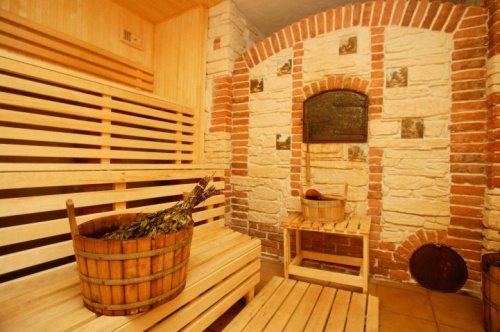
Beauty and environmental friendliness are the key to the benefits of a steam room
It is important to remember that any bath stones require care. Once a year, remove all stones and rinse thoroughly with clean water.
During use, they become covered with a coating that creates an unpleasant odor. Cracked and crumbled stones should be replaced with new ones, and small fragments should be swept up and thrown away.
The video in this article will help you further understand the choice of stones for a bath.
TOP 16 best stones for baths
To obtain pleasant and light steam, building a sauna is only half the battle. It is equally important to properly equip the heater - to select durable minerals that accumulate heat well and give off heat for a long time, preferably with a healing effect. This article is an overview of the best bath stones, both natural and artificial. By studying their properties, advantages and weaknesses, you reduce the risk of encountering compounds harmful to your health to almost zero and will be able to buy stones with the desired characteristics.
Which stones to choose for a bath
Whatever mineral you choose for the steam room, it must meet the following requirements:
- environmental cleanliness;
- homogeneous structure. The presence of inclusions may be beautiful, but heating will occur unevenly, which leads to gradual cracking and destruction of the stone;
- no cracks. The surest way is to tap the stones with a hammer. A clear sound indicates that there are no defects;
- approximately the same size. The heater will heat up evenly;
- absence of carbonates. A sign of the presence of this compound is white spots that are easily scratched with a needle;
- absence of asbestos (it looks like clearly visible fibers on the surface);
- no dust. A prerequisite is the cleanliness of the stones. Therefore, they are washed before laying, even if the dust is invisible during inspection;
- attractive appearance;
- acceptable price. The question of how much it will cost to equip a bathhouse worries most people.
Many buyers ask the question: which stone is better: polished or chipped? The choice depends on the individual preferences of the steamer. For experienced bathhouse attendants, the split option is preferable, since the area of contact with water is larger, and, therefore, steam generation is stronger. Polished stone takes longer to warm up, but the air circulation in the steam room is much better. Due to their high hardness, individual minerals are difficult to process and are therefore sold only in crushed form.
Heat resistance
The sauna heater is subjected to quite severe tests: first it is heated to maximum temperature. When pouring water, it cools down. Therefore, as the heat resistance of the material increases, the risk of cracking due to sudden temperature changes decreases. The following strength test is possible: heat the sample to a high temperature and dip it in cold water. If it doesn't crack, that's the best evidence of its heat resistance.
Heat capacity
This indicator means the ability to warm up quickly and release heat slowly. High heat capacity is one of the most important requirements for heater materials. As a rule, these are minerals with a homogeneous structure and high density. Buying such a stone is a great success. There is a high probability that the steam room will turn out excellent.
Dimensions of stones
The size of the bath stone largely depends on the type of stove. Here the focus is not on aesthetics, but on practical properties:
- large stones (70-150 mm) are suitable for a wood-burning stove;
- for electric furnaces, the best option is smaller pebbles (50-70 mm).
Environmental Safety
Some minerals, even those with ideal performance properties, are unsuitable for baths because they release harmful substances when heated. Therefore, before giving preference to one or another option, you need to carefully study the properties of both the mineral itself and possible impurities.
Mine or buy?
Good minerals for a sauna heater are far from cheap. Therefore, sometimes people engage in “gathering.” For example, sea or river pebbles are stones that can be found in abundance along the banks of reservoirs. Pebbles collected from fresh lakes or along the banks of rivers are more durable and heat-resistant than sea pebbles.
Collecting rocks yourself requires skill and knowledge about minerals. Otherwise, this is not just a thankless, but also an unsafe task. In particular, if you collect pebbles from a railway embankment, you risk paying for your own health. Treated with chemicals, stones emit a harmful odor when heated. And the fumes from them are completely dangerous. Not to mention the fact that the purpose of a railway embankment is somewhat different than the supply of stones for a private bathhouse.
Another advantage of buying in a specialized store is the opportunity to purchase minerals of the desired type, and not just something that came to hand by chance. The set of stones “from the store” is balanced not only in chemical composition, but also in size. The samples are treated with special environmentally friendly compounds that destroy harmful microorganisms.
Champion stones
Let's compare materials for a heater in a sauna or Russian bath according to various parameters:
- durability - ceramics, jade;
- heat capacity - porphyrite;
- safety - dunite, jadeite, peridotite;
- cheap - gabbro-diabase.
More detailed information about the physical properties of minerals can be gleaned from comparative reference tables.
Soapstone for baths: properties depending on the chemical composition
The chemical composition of the rock can be expressed by a formula, but it will be conditional. Soapstone is described as follows:
The hydroxyl group is chemically bound water, which is present in soapstone in fairly large quantities.
This suggests that the service life of soapstone in a heater is limited by its “reserves” of water.
Sulfides
Officially, they are not part of soapstone, but are often “stowaways.” An admixture of sulfides is characteristic, for example, of many Karelian stones.
Unfortunately, this is the most unpleasant part. When heated, sulfur compounds decompose and transform into oxides, which react with water to form acids . Inhaling air containing sulfuric or sulfurous acid vapor causes a burn to the nasopharynx. In addition, the mucous membrane of the eye suffers. It all manifests itself in the form of a sore throat, cough, and stinging eyes . At the same time, the smell is extremely unpleasant.
The amount of sulfides may be small, in which case unpleasant sensations arise only during the first penetrations , and then do not appear at all.
Useful video
By the way, there is a video that says that talc on heated metal begins to smell bad. We would venture to assume that the problem is not talc, but sulfur compounds. Perhaps the air, when heated, did not reach them immediately, but after several months, during which some of the talc and chlorite managed to collapse (as evidenced by the mentioned dust). Sulfides will not necessarily be on the surface. As for sintering of talc - yes, it does occur, but the temperature must be at least 1300 degrees.
Differences between soapstone and soapstone
Natural stones - soapstone and soapstone - are the best materials for cladding fireplaces or stoves for baths. These materials include components with different percentages - magnesite, talc, chlorite. Both of them accumulate heat and are environmentally friendly.
Based on comments and reviews of stoves made from them, we can conclude that most people do not distinguish between these two materials, thinking that they are the same thing. Externally, the materials are certainly similar, but different in structure, properties and parameters. Upon closer examination, many differences can be identified.
Based on the name, you can understand that soapstone contains a lot of chlorite and other impurities and minerals, which can sometimes be seen in the form of veins and inclusions in the lining. Soapstone chlorite is not as strong; it is more fragile compared to soapstone magnesite. In addition, a large number of impurities and inclusions of other minerals can lead to defects in facing products. As evidenced by reviews, it happened that during the process of lighting a stove or fireplace with soapstone lining, under the influence of temperature, the substances contained in the inclusions expanded, and cracks appeared on the lining parts. This was often noticed in bathhouse stoves, the temperature in which is much higher than in stoves and fireplaces for heating.
You might think that it is better not to use soapstone chlorite stove lining at all, but this is not so. Manufacturers began to pay more attention to the quality of the stone and improve its operational structure. In addition, a soapstone oven has an acceptable cost (20-30% of the price of soapstone). Because of this, most Russians chose soapstone lining for stoves and fireplaces.
Talkomagnesite for the furnace contains a lot of magnesite, which determines the strength of the material. Potted stone is cleaner and contains fewer impurities, and can easily withstand heating up to 1500 °C and temperature changes. But these properties play a role when choosing it for baths, stoves and fireplaces.
You can read more about the properties of soapstone on this page.
Bath stone soapstone: properties depending on the mineral composition
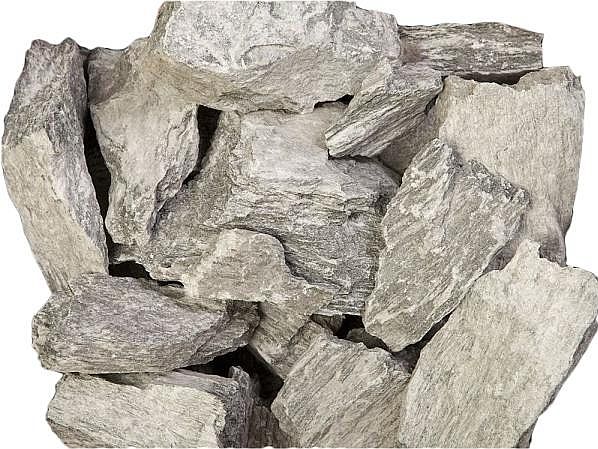
Bath stones: crushed soapstone
Soapstone is a rock composed mainly of two minerals: talc and chlorite . Each of them stands out individually, so it makes sense to talk about each one separately.
Talc
Layered silicate, a product of metamorphism of hypermafic rocks.
We deal with this mineral every time we use baby powder or put on latex gloves. However, in nature it does not exist in the form of powder, but in the form of a very soft stone, the hardness of which is only 1 on the Mohs scale. Or as a composition of soapstone and soapstone. The percentage of talc in soapstone is on average half, but can be more or less, depending on the deposit.
Soapstone is called “soapstone” or “wen” because it is slippery to the touch. This is due to the release of talc. Being very soft, talc separates under any mechanical influence, including, of course, thermal expansion in the oven. White dust on the surface of the stones is what he is. Therefore, you should not think that you will get rid of dust by washing the stones before laying them. It will be released constantly , but not in too large quantities.
Chlorite
Another soft mineral contained in soapstone.
This is an aluminosilicate, which consists of the thinnest plates, like mica. The hardness of chlorite on the Mohs scale is 2-3. By the way, the presence of chlorine in the name is only apparent . Chlorite does not contain it (or in negligible quantities). It's all about the Greek language and scientists naming elements and minerals. "Chloros" translates to "green". Chemists called the gas and element of the periodic table that way, geologists called it just green stones. In fact, chlorite is not only gray-green, but also brownish, but the latter is no longer reflected in the name).
Due to its softness, chlorite also tends to separate easily under mechanical stress. But not in the form of a fine powder, but as small plates, flakes of the mineral. They also end up on the surface of the stone and can become airborne. The composition will contain oxides of aluminum, silicon, magnesium, and iron.
Where are soapstone tiles used in a bathhouse?
Let's look at two main areas of its bath application. Usually it is used either for lining the stove, or walls (less often floors), or both.
Lining furnaces with soapstone
For this purpose, a polished variety that is not too large : the Finns say that too large can split.
Tiles, by the way, have one feature: when the stone has a layered structure, it has a longitudinal and transverse direction. So, the stone is never cut across, only along the layers .
IMPORTANT! To speed up the heating of the oven for lining it from the inside, square tiles are cut into two rectangles and all the fragments are laid flat on top of each other - maximum heat transfer is achieved there. The outer tiles remain unchanged and are mounted vertically.
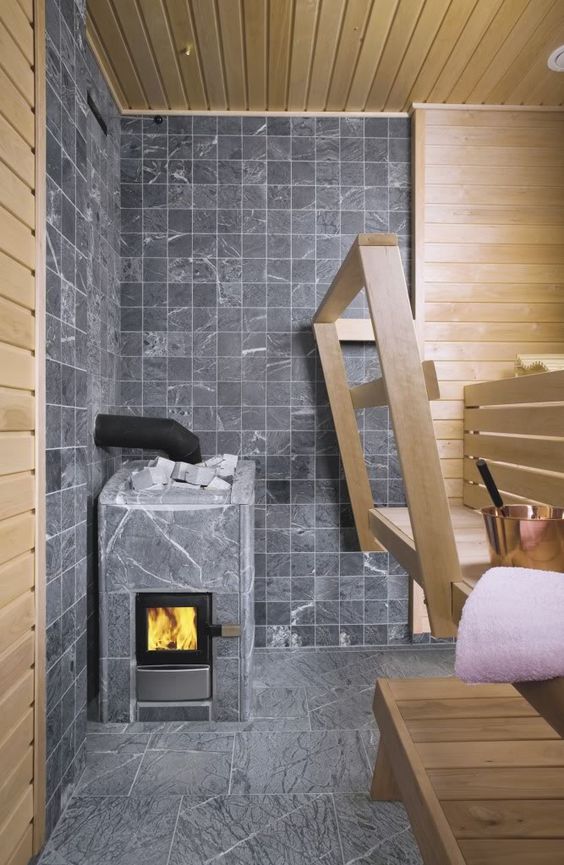
Photo source: Pinterest
To attach tiles to the surface, you need to use a solution with similar thermal characteristics. The Finns came up with a suitable mixture: liquid glass with powdered soapstone.
Until the solution dries, the tiles are held on the surface with staples. The hardening process lasts from 2 to 4 hours , after which the staples can be removed.
Lining of industrial metal furnaces
Furnace (soapstone) Varvara
Usually it is purchased together with a stove in a store, and for some reason it is called “stove made of soapstone,” although we are talking only about finishing.
The fact that the lining is collapsible makes it more convenient - if necessary, the stove can be removed for repair or replacement.
If you already have a stove, but without a stone casing, it can be ordered separately. Or you can do it yourself.
To do this you will have to purchase a brick 40-50 mm thick. They place it on the already mentioned composition of liquid glass.
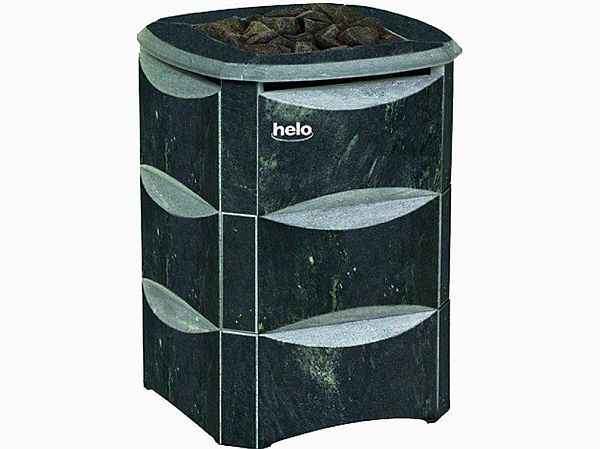
Electric bath stove made of soapstone Helo Seidankivi
Brick stove for a bath in soapstone
A sauna stove with soapstone lining is a fashionable trend. Brick stoves are finished both outside and inside. The principle is described above. The staples, which are used to maintain the vertical position of the tiles on the mortar that has not yet set, leave holes - these places are then treated with grout. In addition to staples, special pins can be used.
Video
We recommend watching a video that demonstrates the process of creating a casing for a furnace in soapstone, from cutting the stone to shipment to the consumer:
Wall and floor cladding
If you wish, of course, you can cover all the surfaces in the bathhouse with it, but much more often they do it differently: they line the firebox and the stove itself, as well as part or the entire wall against which the stove stands. Or a corner, if she stands in the corner.
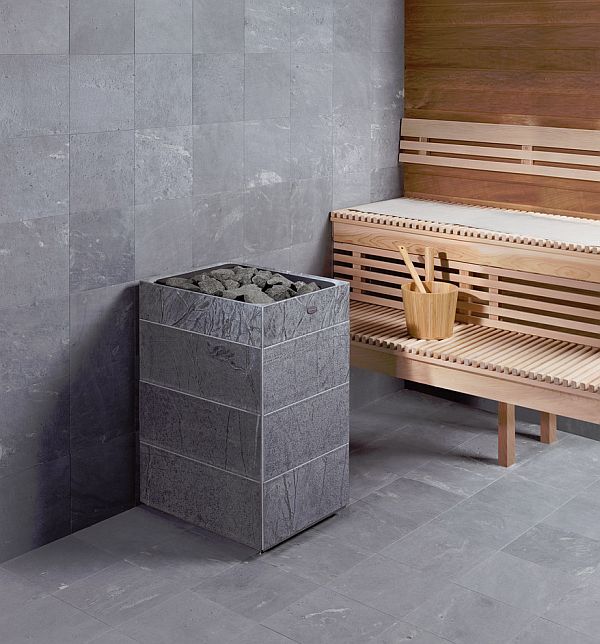
Facing: soapstone (source photo
)
For the walls, either decorative “torn stone” or ground or polished soapstone tiles are used.
IMPORTANT! We will not recommend tiles for the floor, because water on the floor in any case reduces friction, and this can result in injury if you fall.
Physico-mechanical properties of soapstone stone for baths
So far, everything that has been said about soapstone has referred only to the disadvantages of this stone. In fact, it also has undeniable advantages. The most important property of soapstone for a bath is its tendency to slowly and reluctantly give off heat . This is explained by the fact that talc is a poor conductor of heat (and electricity, but the latter is unimportant for a bath).
For any heater filler, the most important things are heat resistance , heat capacity and thermal conductivity . Here are the properties of soapstone stone:
- density: 2.75 g/cm³
- specific heat capacity: c = 0.98 kJ/(kg*Δϑ) or 0.98 J/(g*Δϑ)
- thermal conductivity: λ = 3.3 W / (K*m)
As for thermal stability , it is measured by the number of heating-cooling cycles until the sample is destroyed, and such data are not available. Let us recall that the reason for the loss of strength and destruction of soapstone in the furnace is its dehydration.
Porosity
Affects the strength of the material, wear resistance and resistance to moisture, temperature changes (heating/cooling). Minerals of the talkite category: talkomagnesite and talkie chlorite (the difference for a bath) have significant differences. Minerals with low vapor permeability are durable and are recommended for use as lining for stoves and underfloor heating. The rock, which has significant porosity and, due to its ability to generate finely dispersed steam over a long period of time, works well as a base or filler for heaters.
Which is better for a bath: rolled soapstone or crushed soapstone?
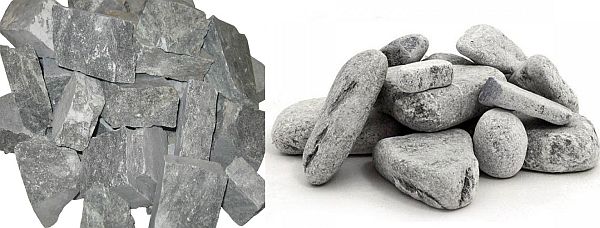
Soapstone (photo): crushed and diked
For many stones, tumbling is mainly a matter of aesthetics, but this is not the case with soapstone. The fact is that this stone generates more dust, the more uneven its surface is . This is why polished samples are less prone to destruction than fragmented ones.
Galvanized or bunded (which is the same thing, but the former is more correct) stone is an intermediate degree of processing between a fragment and a polished sample. It would be strange to put the latter in the heater, so it is better to take bunded soapstone.
Physicochemical properties of soapstone
Good heat conductivity, in comparison with other materials, is a consequence of the dense structure and mineral composition. This property determines the rapid and high-quality heating of soapstone from all structural sides.
Heat accumulation is the energy that a material can hold relative to weight or volume, as well as temperature unit.
The thermal capacity of soapstone is about 1 J/gK, and the density is approximately 3 g/cm³, and heat accumulation relative to a unit volume is 3 J/cm³K. The mineral magnesite is characterized by high conductivity and heat capacity. Soapstone magnesite has the same indicator 0.84 J/gK, that is, the heat capacity of soapomagnesite is 20% greater than these indicators.
In just a few hours, fireboxes, stoves and fireplaces made of soapstone accumulate such an amount of heat that can keep a room of up to 120 m² warm throughout the day.
Wave tiles made of soapstone
Many people believe that if a stone is soft, then it must have a porous structure. The high density of soapstone gives confidence that its structure is not porous. The rock's formation rocked more than two billion years ago when exposed to intense pressure and heat. Moisture sticks only to the surface of the material, but even under pressure it cannot penetrate inside. According to the results of the Finnish technical research center, the value of visible porosity is only 0.08%. The porosity of high-quality building stone can vary from 0 to 30%. The potting stone has a dense structure.
Moisture that penetrates into the natural material makes the strength weaker in almost all types of stone. When it gets wet from the inside, deformation occurs. The good density of the potting stone does not allow moisture and chemicals to get inside, so the material is not afraid of the negative parameters described above.
In practice, it has been proven that soapstone is resistant to temperature heating and can withstand temperatures from 1200 °C to 1600 °C for a long time, depending on the type of stone. Under the influence of temperature, the material does not crack or deform.
The physicochemical properties of soapstone are presented in the table.
| Property | Meaning |
| Specific gravity (density) | 2.8-3.0 g/cm³ |
| Compressive strength | 25.0-100.0 MPa |
| Thermal conductivity | 3.5-4.7 W/(m °C) |
| Clutch | 7.0 MPa |
| Heat capacity | 800-900 J/(kg °C) |
| Water absorption | 0,3 % |
| Fire resistance | 1230-1360 °C |
| Acid resistance | 39,0-41,0 % |
| Abrasion | 1.43 g/cm³ |
| Electrical conductivity | 0,44·10-7 |
| Breakdown voltage | 20.0 kV/s |
